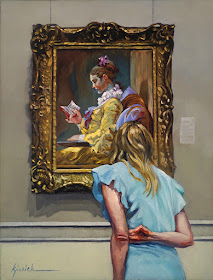6 x 8"
oil on panel
sold
sold
Brett's comment to my finished painting was "The shine on the apple looks like the shine on the man's bald head." Such a great observation and it didn't occur to me.
Rene Magritte's The Son of Man is widely known and endlessly satirized. Magritte painted this surrealist self-portrait in 1964. It's simplistic. It's ambiguous. Left to interpretation like most Surrealism-style works of art.
Rene Magritte started his artistic career as an Impressionist but his wit took over, wanting to paint more thought-provoking subject matters. His first gallery exhibition in 1927 left the art critics puzzled and expressing a thumbs-down review so he moved to Paris meeting up with fellow surrealist artist - Joan Miro and Salvador Dali notably. Although he tried, the critics in Paris weren't much different so he moved back to Brussels jumping back on the Impressionist bandwagon for a time in 1930. It wasn't until the late 40's did Magritte revert back to Surrealism and the time, after the war, critics and patrons seemed to click with his work for the first time.
The Son of Man features a bowler hat, a prop that appears constantly in Magritte's work. They say the hat hinted at his political leaning to the Communist party. It's the shiny green apple, hiding most of Magritte's face, that's most curious. There is a theory it refers to Christianity, as a symbol of the common man surrendering to temptation like Eve in the Garden of Eden. Another interpretation is the apple simply hides a man's true self from society. That is Surrealism. We see what we want to see.
~ Stay safe. Stay healthy. Wear a mask.


